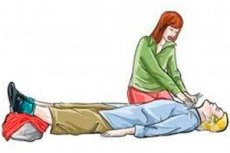Medical expert of the article
New publications
First aid for loss of consciousness
Last reviewed: 30.06.2025

All iLive content is medically reviewed or fact checked to ensure as much factual accuracy as possible.
We have strict sourcing guidelines and only link to reputable media sites, academic research institutions and, whenever possible, medically peer reviewed studies. Note that the numbers in parentheses ([1], [2], etc.) are clickable links to these studies.
If you feel that any of our content is inaccurate, out-of-date, or otherwise questionable, please select it and press Ctrl + Enter.

Loss of consciousness can be caused by a variety of reasons, including fainting, seizures, low blood pressure, heart problems, injuries, or other medical conditions. If you are in a situation where someone has fainted, follow these steps:
- Call for medical help: If a person has lost consciousness, the first step is to call for medical help. Call the emergency number (112 or 911 in most countries) and report the incident.
- Make sure the environment is safe: Check that the area where the casualty is located is safe. Remove sharp or dangerous objects from his or her immediate vicinity to avoid further injury.
- Turn the casualty on his or her side: If the person is lying on his or her back, gently help him or her turn on his or her side. This may help prevent choking if the person has vomiting or discharge from the mouth.
- Check for breathing and pulse: Gently touch the victim's face and try to determine if he or she is breathing. See if there is a pulse at the neck or wrist. If the person has stopped breathing or has no pulse, begin CPR.
- Perform CPR: If the person has no breath or pulse, begin cardiopulmonary resuscitation (CPR) immediately. This includes chest compressions and CPR. If you are not familiar with CPR techniques, follow the instructions of the ambulance operator on the phone.
- Stay with the casualty: Until medical help arrives, stay with the casualty and continue to monitor his/her condition. Continue to provide CPR if necessary.
- Inform medical professionals: When medical help arrives, provide them with all available information about the casualty's condition and the actions that were taken.
If you find yourself in a situation where someone has passed out, but you have already called for medical help and are following the ambulance operator's instructions, there are additional steps you can take to help the injured person:
- Provide access to fresh air: If the casualty is in an enclosed area, make sure there is access to fresh air. This may help to restore consciousness.
- Support the head and neck: If a neck or spinal injury is suspected, gently support the victim's head and neck to avoid additional injury.
- Pay attention to signs of improvement or deterioration: Observe the casualty and pay attention to signs of improvement or deterioration. If there are signs of allergic reaction, choking or other complications, notify medical personnel when they arrive.
- Gather information: Try to gather information about the casualty's condition before he or she lost consciousness, such as medical history, medication intake, and symptoms he or she experienced before losing consciousness. This information may be helpful to medical personnel.
- Calm and supportive: If you are near the victim, try to remain calm and supportive. Even if he or she cannot hear you, your presence and support can be important.
Remember that loss of consciousness can be caused by serious medical problems, so it is important to call professional medical help as soon as possible.
Literature used
Bagnenko, Miroshnichenko, Khubutia: Emergency Medical Care. National manual. GEOTAR-Media, 2021.

